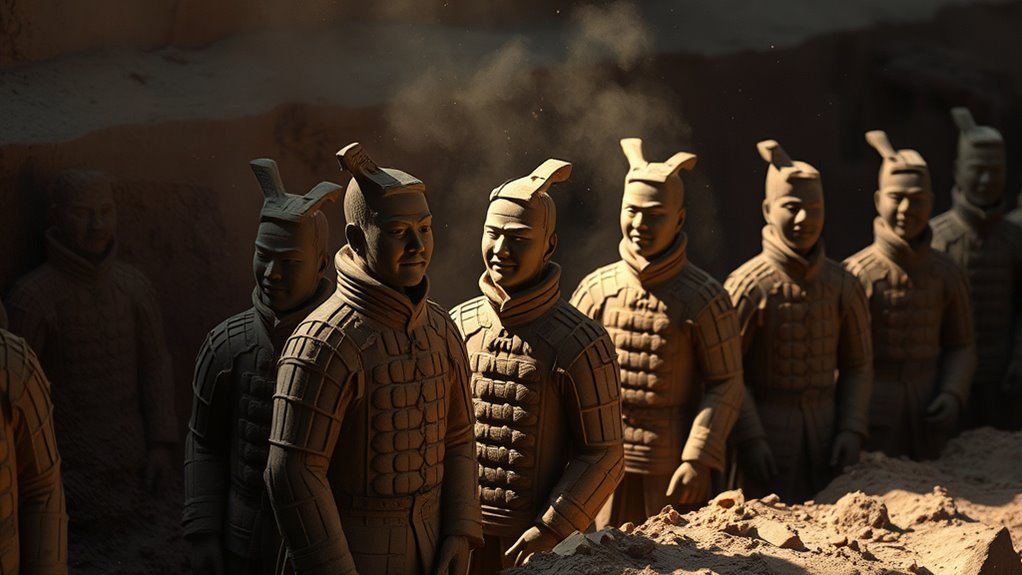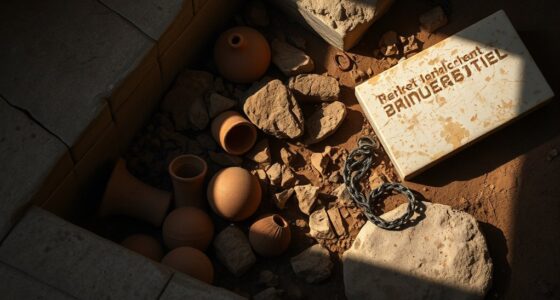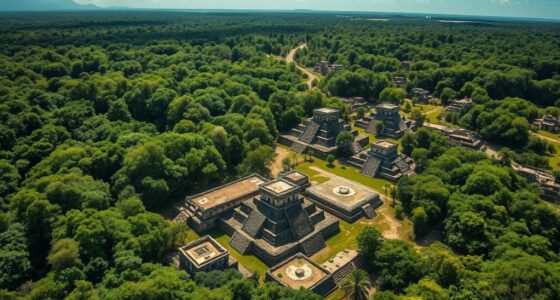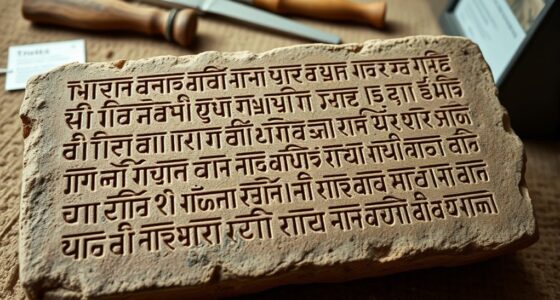Recent discoveries around the Terracotta Army have expanded our knowledge of the Qin Shi Huang mausoleum, revealing new sections and artifacts that deepen our understanding of ancient Chinese burial practices. Archaeologists use advanced techniques like ground-penetrating radar and careful excavation to uncover fragile relics without damage, uncovering more life-sized soldiers, weaponry, and ritual objects. These finds highlight the sophistication of the burial and the importance placed on eternity, offering fascinating insights that you’re sure to find intriguing as you explore further.
Key Takeaways
- Recent discoveries expand the known boundaries of Qin Shi Huang’s mausoleum complex.
- New finds provide deeper insights into ancient Chinese funerary customs and rituals.
- Advanced archaeological techniques reveal previously hidden underground structures and artifacts.
- Ongoing excavations uncover additional terracotta figures, weapons, and decorative elements.
- These discoveries enhance understanding of the scale, craftsmanship, and cultural significance of the site.
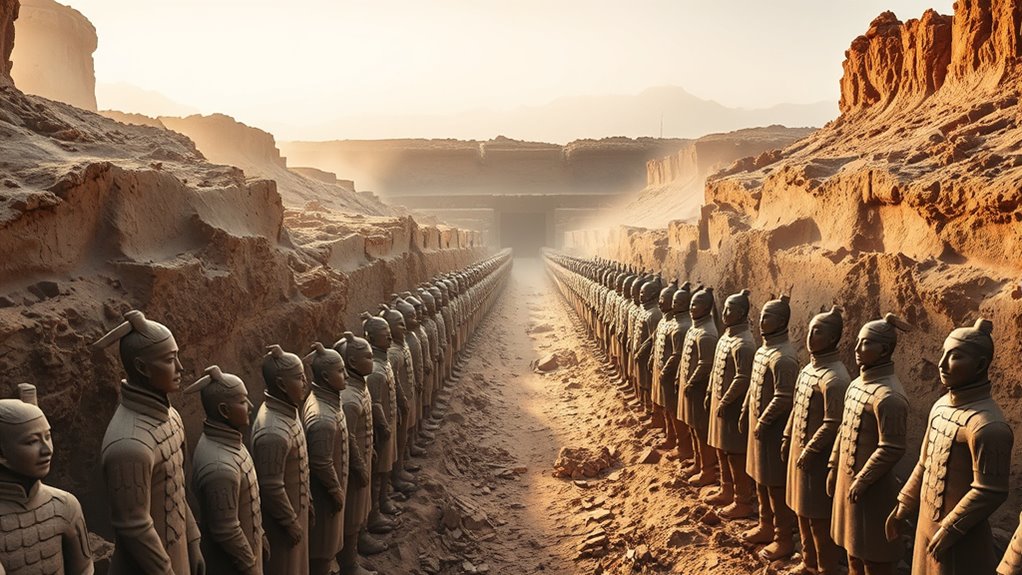
Have you ever wondered what secrets lie beneath the sands of China? The discovery of the Terracotta Army has fascinated archaeologists and history enthusiasts alike, revealing a glimpse into the elaborate funeral rituals of China’s first emperor, Qin Shi Huang. These life-sized clay soldiers, horses, and chariots were buried to serve him in the afterlife, embodying the grandeur and military strength of his reign. As excavations continue, new finds are extending the boundaries of this vast mausoleum, uncovering more about the ancient practices surrounding death and the afterlife.
Archaeological techniques have been vital in unearthing these hidden treasures. Modern methods like ground-penetrating radar and careful excavation strategies help archaeologists avoid damaging fragile artifacts. These techniques allow for precise mapping of what lies beneath the surface, revealing complex underground structures without unnecessary disturbance. When new terracotta figures or parts of the mausoleum are discovered, experts analyze their placement and craftsmanship to understand the rituals performed during the burial. Such insights illuminate how ancient Chinese society approached death, emphasizing the importance of elaborate funerary practices to honor the deceased.
The excavation process itself is meticulous. Archaeologists often work in layers, carefully removing soil to reveal the buried army without destroying its context. This method guarantees that every piece of information, from the positioning of figures to the material composition, is preserved. When new sections of the mausoleum are uncovered, researchers examine the layout to see how the figures were arranged—whether in formation or scattered—offering clues about the funeral rituals and beliefs of that time. The discovery of smaller statuettes, weaponry, or even remnants of pigments helps reconstruct the sensory experience of the burial ceremony, emphasizing the significance of ritual in securing a safe passage to the afterlife.
As ongoing excavations extend the mausoleum, more of its secrets are coming to light. Each new find adds depth to our understanding of ancient Chinese funerary customs, illustrating a society that invested immense effort into guaranteeing their rulers’ eternity. The combination of traditional archaeological techniques and modern technology continues to push the boundaries of what we know about this extraordinary archaeological site. With every dig, you get closer to understanding how the ancient Chinese envisioned life after death and how they used art, ritual, and engineering to create a timeless monument to their emperor’s legacy.
Frequently Asked Questions
What Materials Were Used to Craft the New Terracotta Figures?
You wonder about the materials used for the new terracotta figures. The craftspeople primarily used local clay with a ceramic composition suitable for detailed modeling. Pigment analysis reveals that vibrant paints, including iron oxide for reds and other minerals for colors, were applied to decorate the figures. These materials helped bring the sculptures to life, matching the craftsmanship seen in the original army while showcasing advancements in ancient ceramic and pigment techniques.
How Do the New Finds Change Our Understanding of the Mausoleum’S Layout?
You might be amazed to learn that recent discoveries reveal over 8,000 figures, suggesting a much more complex mausoleum architecture than previously thought. The new finds shed light on the burial chamber layout, indicating multiple chambers and corridors that weren’t documented before. This changes your understanding of the site, showing it was a vast, sophisticated complex designed to protect and honor the emperor in an elaborate, multi-layered structure.
Are There Any Inscriptions or Markings on the Newly Discovered Figures?
You wonder if the newly discovered figures have inscriptions or markings. Inscriptions analysis reveals that some figures do have faint markings, which could be significant for understanding their identities or roles. These markings might indicate rank, origin, or purpose, adding depth to our knowledge of the army. Their presence helps archaeologists piece together the cultural and historical context, making each find more meaningful and revealing about the ancient practices behind the mausoleum.
What Conservation Efforts Are in Place for the New Terracotta Discoveries?
You should know that conservation efforts focus on artifact preservation and visitor management. Experts carefully stabilize the new terracotta figures to prevent damage while managing visitor flow to protect these fragile discoveries. You’ll find that controlled access and advanced conservation techniques help guarantee the artifacts remain intact for future generations. These measures balance public interest with the need to preserve the historical significance of the site.
How Might These Finds Influence Future Archaeological Excavations?
You might find that these discoveries subtly reshape how future excavations unfold, prompting archaeologists to refine excavation techniques to better navigate preservation challenges. As they seek to uncover more, you’ll see a shift toward more delicate, innovative methods that protect artifacts while revealing new insights. These finds encourage a cautious approach, balancing enthusiasm with care, ultimately leading to more responsible and insightful explorations of history’s hidden layers.
Conclusion
As you imagine walking through the vast mausoleum, it’s clear that these new discoveries deepen the story behind China’s first emperor. Will future finds paint an even richer picture of ancient craftsmanship and belief? With each new artifact, you get closer to understanding the incredible devotion and artistry that went into creating this underground army. Isn’t it amazing how these timeless figures continue to surprise and inspire us, revealing secrets buried for over two millennia?
